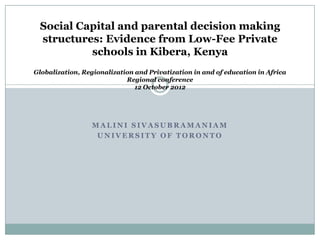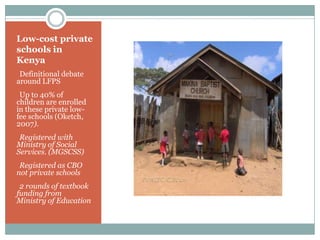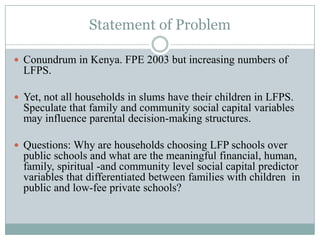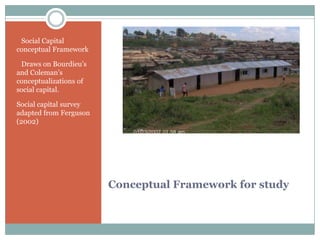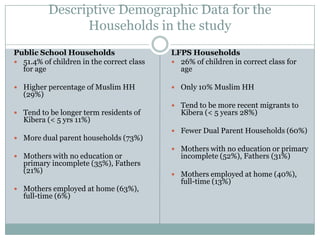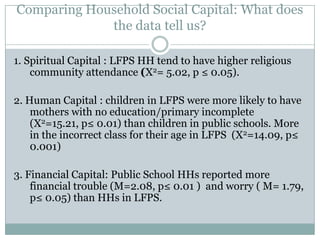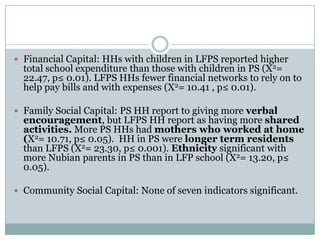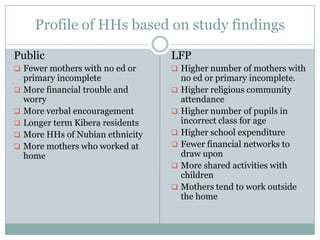Social capital and parental decision-making structures: Evidence from low-fee private schools in Kibera, Kenya
- 1. Social Capital and parental decision making structures: Evidence from Low-Fee Private schools in Kibera, Kenya Globalization, Regionalization and Privatization in and of education in Africa Regional conference 12 October 2012 MALINI SIVASUBRAMANIAM UNIVERSITY OF TORONTO
- 2. OVERVIEW ï Research background, purpose and context ï Low-cost schools in Kenya ï Methodology ï Results ï Concluding Thoughts
- 3. Low-cost private schools in Kenya ï§Definitional debate around LFPS ï§Up to 40% of children are enrolled in these private low- fee schools (Oketch, 2007). ï§Registered with Ministry of Social Services. (MGSCSS) ï§Registered as CBO not private schools ï§2 rounds of textbook funding from Ministry of Education
- 4. Statement of Problem ï Conundrum in Kenya. FPE 2003 but increasing numbers of LFPS. ï Yet, not all households in slums have their children in LFPS. Speculate that family and community social capital variables may influence parental decision-making structures. ï Questions: Why are households choosing LFP schools over public schools and what are the meaningful financial, human, family, spiritual -and community level social capital predictor variables that differentiated between families with children in public and low-fee private schools?
- 5. ïžSocial Capital conceptual Framework ïžDraws on Bourdieuâs and Colemanâs conceptualizations of social capital. Social capital survey adapted from Ferguson (2002) Conceptual Framework for study
- 6. Bourdieuâs and Colemanâs Capitals Operationalized as Indicators used Cultural Capital Human Capital 1) Motherâs educational level 2) Fatherâs educational level 3) Childâs current school status (if enrolled in correct class level for age) Social Capital Family Capital 1) Family structure 2) Quality of parent-child relationship 3) Adultâs interest in child 4) Parentâs monitoring of childâs activities 5) Degree of extended family exchange and support Community Capital Community Capital 1) Perception of the quality of the neighbourhood 2) Social support networks 3) Civic engagement 4) Trust and safety 5) Group membership 6) School satisfaction 7) School choice processes Spiritual Capital Spiritual Capital 1) Degree of religiosity 2) Level of church or spiritual community involvement 3) Church membership 4) Identified religion 5) Level of church or spiritual community activities involvement Economic Capital Financial Capital 1) Total household income 2) Public assistance 3) Kin financial help 4) Financial support networks 5) Economic hardship 6) Perceived financial need 7) School-related expenses
- 7. Methodology ï Research Site: One district in the slum of Kibera ï Schools: Area Cluster Sampling of 5 schools ï Sampling of households: Those with children in Class 6 and 7 in each of the schools and closest place of residence to the school. ï Sample size: 100 (LFP schools), 109 (public school) N=209 ï Survey and in-depth interviews
- 8. Table XXXX Summary of Focus School profiles Government School 1 School 2 School 3 School 4 Year established 1953 1994 1998 2000 1994 Number of years in present premise* 54 8 8 7 13 Category of school type Public Individual Community- INGO Faith-based proprietor based/INGO Partners None None First love, USA Childlife Survival Ministries, Anglican Church of international, Kenya Netherlands Registered with City Council of Ministry of Ministry of Ministry of Ministry of Gender, Sports, Culture and Nairobi Gender, Sports, Gender, Sports, Gender, Sports, Social Services Culture and Culture and Culture and Social Services Social Services Social Services Grades offered 1-8 Nursery, 1-6 1-8 1-7 1-8 Reported total enrolment 2233 135 341 548 265 Teacher-student ratio 1:67 1:22 1:24 1:45 1:26 Number of trained teachers 33 0 11 9 5 Number of support staff 6 2 5 11 3 Fee collected/month(Ksh) 50 150 300 none 150 Fee concessions No Yes Yes Yes Yes Sponsored pupils 0 0 4 0 0 Reported no. of free and 26 4 10 All 10 concessionary places Number of Classrooms 36 7 11 9 5 Water Yes No Yes Yes Yes Electricity Yes No Yes Yes No Number of toilets 20 3 16 5 4 Playground Yes No Yes No No School feeding program Yes, World YES, Feed the Yes, World Yes, World Yes, World Food Program Feeding Children Food Program Food Program Program and and First Love, Feed the USA children Math textbook ratio in Class 1 1:2 1:19 1:4 1:6 1:3 Math textbook ratio in Class 7 1:1 1:6^ 1:3 1:4 1:2 Textbook funding received from Yes No Yes Yes Yes Ministry Classroom construction material Brick, concrete Mud-walled, Brick Part brick/part Mud-walled, dirt floor floors dirt floor mud-walled
- 9. Descriptive Demographic Data for the Households in the study Public School Households LFPS Households ï 51.4% of children in the correct class ï 26% of children in correct class for for age age ï Higher percentage of Muslim HH ï Only 10% Muslim HH (29%) ï Tend to be more recent migrants to ï Tend to be longer term residents of Kibera (< 5 years 28%) Kibera (< 5 yrs 11%) ï Fewer Dual Parent Households (60%) ï More dual parent households (73%) ï Mothers with no education or primary ï Mothers with no education or incomplete (52%), Fathers (31%) primary incomplete (35%), Fathers (21%) ï Mothers employed at home (40%), full-time (13%) ï Mothers employed at home (63%), full-time (6%)
- 10. Comparing Household Social Capital: What does the data tell us? 1. Spiritual Capital : LFPS HH tend to have higher religious community attendance (ÐĨ2= 5.02, p âĪ 0.05). 2. Human Capital : children in LFPS were more likely to have mothers with no education/primary incomplete (ÐĨ2=15.21, pâĪ 0.01) than children in public schools. More in the incorrect class for their age in LFPS (ÐĨ2=14.09, pâĪ 0.001) 3. Financial Capital: Public School HHs reported more financial trouble (M=2.08, pâĪ 0.01 ) and worry ( M= 1.79, pâĪ 0.05) than HHs in LFPS.
- 11. ï Financial Capital: HHs with children in LFPS reported higher total school expenditure than those with children in PS (ÐĨ2= 22.47, pâĪ 0.01). LFPS HHs fewer financial networks to rely on to help pay bills and with expenses (ÐĨ2= 10.41 , pâĪ 0.01). ï Family Social Capital: PS HH report to giving more verbal encouragement, but LFPS HH report as having more shared activities. More PS HHs had mothers who worked at home (ÐĨ2= 10.71, pâĪ 0.05). HH in PS were longer term residents than LFPS (ÐĨ2= 23.30, pâĪ 0.001). Ethnicity significant with more Nubian parents in PS than in LFP school (ÐĨ2= 13.20, pâĪ 0.05). ï Community Social Capital: None of seven indicators significant.
- 12. Profile of HHs based on study findings Public LFP ïą Fewer mothers with no ed or ïą Higher number of mothers with primary incomplete no ed or primary incomplete. ïą More financial trouble and ïą Higher religious community worry attendance ïą More verbal encouragement ïą Higher number of pupils in ïą Longer term Kibera residents incorrect class for age ïą More HHs of Nubian ethnicity ïą Higher school expenditure ïą More mothers who worked at ïą Fewer financial networks to home draw upon ïą More shared activities with children ïą Mothers tend to work outside the home
- 13. Public(N= 109) LFP (N=100) Reasons for choice % % I.Practical considerations (total) (40.9) (25.1) (i) safe 1.1 1.1 (ii) Proximity 29.0 16.0 (iii) Feeding program 1.1 4.0 (iv) Other siblings in the school 9.7 4.0 II. Access(total) (20.4) (17.0) (i)Availability of space 16.1 12.0 (ii)Easier admission 4.3 5.0 III.School quality(total) (20.4) (46) (i)Good discipline 0.0 3.0 (ii)Good teaching 3.2 7.0 (iii)Higher academic standards 14.0 21.0 (iv)Good performance record 3.2 12 (v)Smaller class sizes 0.0 3.0 IV. Financial considerations(total) (65.6) (59.0) (i)Fee concessions 1.1 5.0 (ii)Affordability 29.0 35.0 (iii)Child sponsorship 0.0 3.0 (iv)Flexible fee payment 0.0 7.0 (v) FPE 35.5 0.0 (vi) School offerd assistance 0.0 9.0 V. Community Social Capital(total) (13.0) (31.0) (i)Parent former pupil 8.6 0.0 (ii)Other people recommended 0.0 10.0 (iii) Attend community group here 0.0 4.0 (iv)Teacher/Staff is a friend 1.1 4.0 (v) School is community-based 2.2 0.0 (vi)School supportive of HIV AIDS parents 0.0 2.0 (vii)Neighbourâs child enrolled here 0.0 7.0 (viii)Teacher/staff understanding 1.1 4.0 VI. Peripheral Reasons(total) (4.2) (6.0) (i)Child selected 1.0 1.0 (ii)No particular reason 3.2 5.0
- 14. Comparing ranked relative importance of reasons given by public and LFP school households for choosing their current school Public school households LFP households 1. Financial considerations 1. Financial considerations 2. Practical considerations 2. School Quality 3. Access 3. Community Social Capital 4. School Quality 4. Practical considerations 5. Community Social Capital 5. Access 6. Peripheral Considerations 6. Peripheral considerations
- 15. Clear differentiation along certain social capital variables between the two groups of households. Decision-Making is an shaped by HH SC but not all households able to exercise the ability to choose. In many cases, households are pushed into a choice by their inability to access their first choice esp. public schools because of lack of space or cost. Also evidence of schools choosing. Some Concluding Thoughts Emergence of what can be described as three kinds of choosers of LFPS: Default, Strategic and Active

